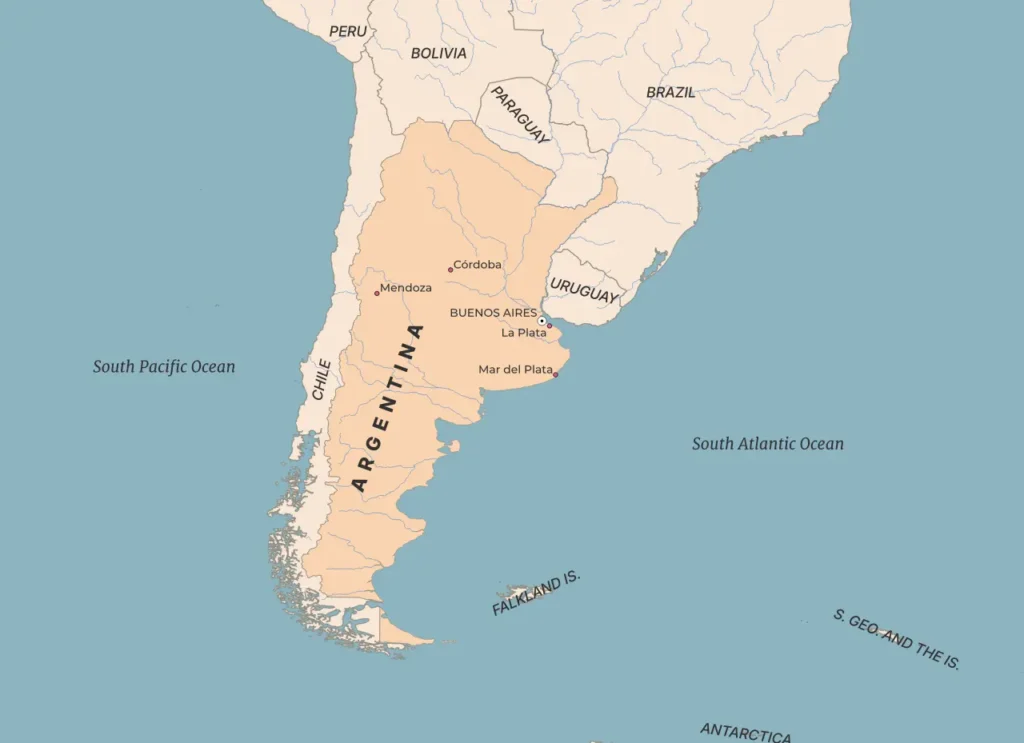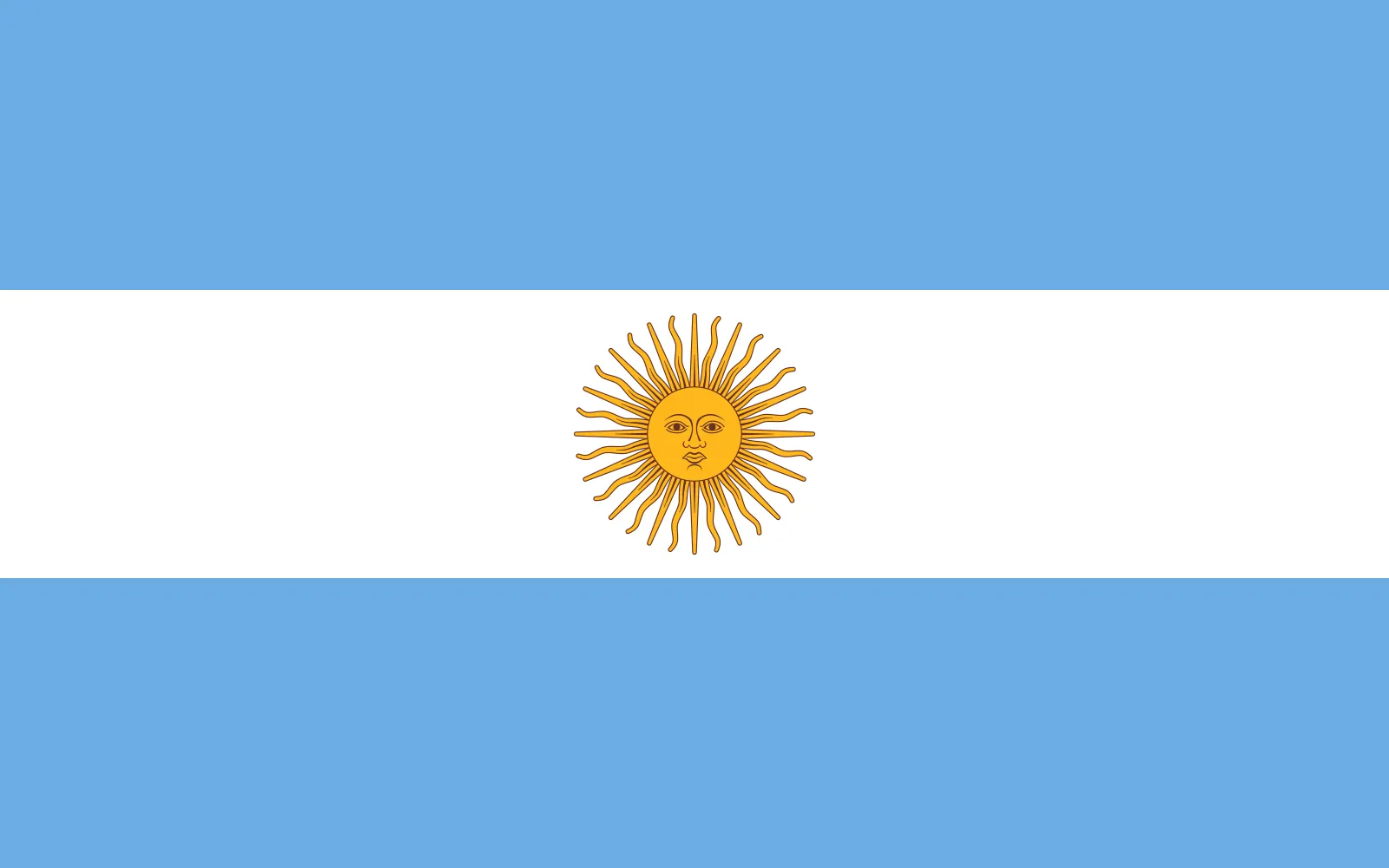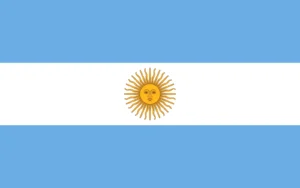Argentina Fact Sheet
- Area: 2.780,400 km ²
- Population: Over 44.7 Million
- Population Density: ~16 people/ km ²
- Climate Type: Mostly subtropical
- Dominant Language: Spanish
- Dominant Religion: Roman Catholicism(Christianity)
- Currency: Argentine Peso(ARS)
- Government: Presidential Representative Democratic Republic
- GDP: 1.24 Trillion USD in 2024
- Major Export: Agri Products, Automobile and Electronics
- Capital: Buenos Aires
- Iconic Monuments: The Obelisk
Argentina Flag:
The three equal horizontal bands of sky blue (top), white, and sky blue; centred in the white band is a radiant yellow sun with a human face known as the Sun of May; the colors represent the clear skies and snow of the Andes; the sun symbol commemorates the appearance of the sun through cloudy skies on 25 May 1810 during the first mass demonstration in favour of independence; the sun features are those of Inti, the Inca god of the sun
know more about Australia
Argentina Map

History of Argentina
On arriving in 1516, the Spanish took 300 years to govern the nation. In 1806, a British force overcame Spanish forces in Buenos Aires and attacked the Malvinas Islands, also called the Falkland Islands. Though they never took back control of the islands, the locals were able to retake the capital. Spain’s control over Argentina loosened as a result of these developments.
After Napoleon’s army captured all of Spain’s principal towns in 1810, the Argentine people were given the authority to rule their own nation. They obtained independence in 1816.
Following the military’s takeover of the nation in 1976, an era known as the “dirty war” saw the deaths of up to 20,000–30,000 rebels or their supporters.
General Leopoldo Galtieri, the president of Argentina, invaded the Falkland Islands in 1982, believing the British would not resist. The islands are located off the coast of the Atlantic Ocean. Galtieri made a mistake, and the British soldiers triumphed handily. Following the loss, the nation transitioned to civilian rule and democracy.
Argentina Geography
Argentina is a country located in the southern part of South America. Approximately one-third the size of the United States, it is the second largest country in South America after Brazil and the eighth largest country in the globe overall. Chile borders Argentina to the west and the Andes Mountains to the east.
The country’s interior is a flat, rich grassland known as the Pampas to the east of the Andes. The Atlantic Ocean forms the nation’s eastern boundary. Paraguay is to the north, and Bolivia is to the northwest. An inherently formed border between Chile and Argentina spans 3,195 miles (5,141.9 kilometers) along the Andes Cordillera, the high mountain spine of the Andes.
Argentina Interesting Facts
- Cave of Hands: One of the oldest instances of human settlement in the Americas is Cueva de las Manos, or the “Cave of Hands,” located in Patagonia, which includes hand paintings dating back more than 9,000 years.
- Origin of Ballpoint Pen: In the year 1938, Hungarian-Argentine writer László Bíró created the ballpoint pen.
- Southernmost City in the World: Ushuaia is known as the southernmost city in the world.
- Fiver Presidents in ten days: In 2001, Argentina had five presidents in ten days.
- Largest Spanish-Speaking Country: Argentina is the largest Spanish-speaking country, we are talking in terms of land area, not in terms of people count.
- Birthplace of Tango: Argentina is the birthplace of the tango, a world-famous dance and music genre that originated in Buenos Aires in the late 19th century.
- Famous for Wine: Argentina is one of the largest wine producers in the world, you want to know the famous variety? Its Malbec wines from the Mendoza region.
- Avenue 9 de Julio: Buenos Aires is home to Avenida 9 de Julio, one of the widest avenues in the world, named after Argentina’s Independence Day, July 9th.
- Mount Aconcagua: Located in the Andes of Argentina is Mount Aconcagua, the highest mountain in both the Southern and Western Hemispheres, standing at 6,959 meters.
- Land Dispute With United Kingdom: Argentina has had a long-standing territorial dispute with the United Kingdom over the Falkland Islands (Islas Malvinas), which even led to the Falklands War in 1982.
- Football Legacy: Argentina is a football powerhouse, having won the FIFA World Cup thrice (1978,1986, and 2022). It has also been runner-up three times: in 1930, 1990 and 2014. Argentina has produced legendary players like Diego Maradona and Lionel Messi.
- Iguazú Falls: Did you know that located on the border between Argentina and Brazil, Iguazú Falls is one of the world’s most spectacular and largest waterfall systems?
- Diverse Climate: The vast size of Argentina means it has various climates, from subtropical in the north, temperate in the central region, to polar in the far south.
- First Country to Use Fingerprints in Criminal Investigations: Argentina was the first country in the world to use fingerprinting as a method of identification in criminal cases, starting in 1892.
Geography of Brazil: Watch now
A hidden gem nestled in the mountains of Europe Watch now

